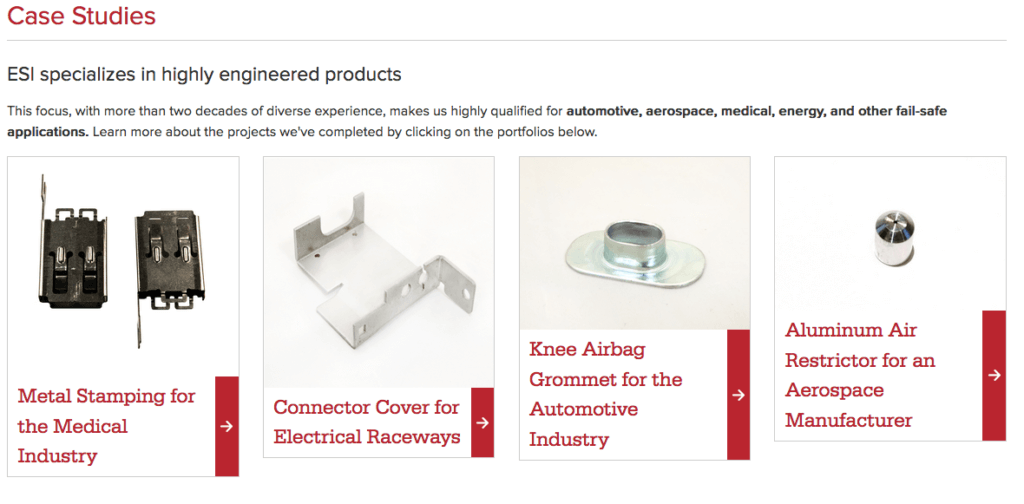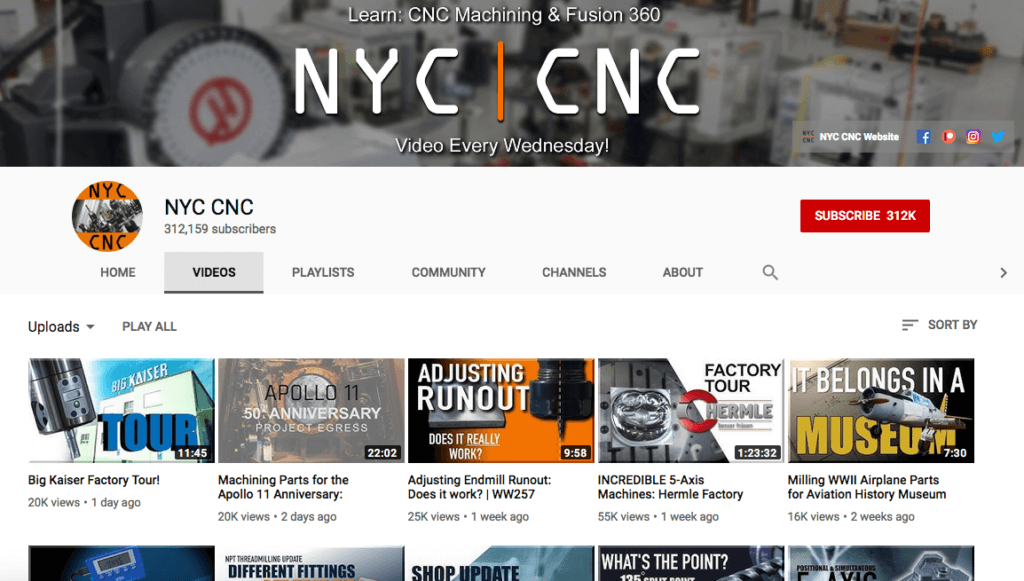Content Marketing for Industrial & Manufacturing Industries

Content marketing for manufacturers is not always the same as for other industries. Learn what makes it different and how you can stand out. Too often, we think that if an industry isn’t flashy or glamorous enough, it’s not worth shouting about.
The manufacturing space is filled with products and services that many consider “boring” and not-so-sexy. As a result, creating captivating content is a common headache among marketers in the industry.
However, by tailoring your content correctly, you can create endless opportunities for your manufacturing business—from boosting brand awareness to generating leads and gaining the trust of your target audience.
So where do you begin? We’ve highlighted key things to keep in mind and the best types of content to produce results for industrial companies.
Let’s get started.
What Makes Content Marketing Different For Manufacturing and Industrial Companies?
Although content marketing is a universal marketing tactic, it’s not the same for everyone.
Finding relevant content ideas is a challenge for manufacturing brands. In fact, 68% of manufacturers report struggling to create content for multi-level roles. Here are the factors that make content marketing for industrial marketers different than for other industries:
- Complex Products: Manufacturing companies tend to sell more complex products, which sometimes need deep expertise to understand and use.
- They’re In A “Boring” Industry: Many marketers in industrial fields believe their market to be too dull, struggling to find ideas for captivating content as a result.
- Audiences Expect Expertise: Audiences in manufacturing markets are not looking to be sold to. They expect efficiency and expertise from manufacturing brands before they can trust them.
- Longer Buying Cycles: Since manufacturers are looking to reach business decision-makers, the buying cycle for manufacturing companies is longer.
- Specialized Niches: Many manufacturers offer products that are in a highly specialized niche, used in only a handful of uncommon situations.
- Market Information: Finding information on manufacturing market niches can be difficult and can require industrial experience to acquire.
Considerations for B2B manufacturers' content marketing
While content marketing for manufacturers has its fair share of challenges, they can be overcome with the right mindset and strategy.
Here are vital things to consider before launching your content marketing campaign:
1. Understand the Buying Process
The buying cycle for manufacturing and industrial companies can be broken down into three stages:
- Awareness – The prospect has a need or an issue they want to resolve.
- Consideration – The prospect begins researching possible solutions for their problem.
- Decision – The prospect pulls the trigger and decides on the best solution.
As a manufacturing business, your first goal should be to identify your customers’ pain points and to consider the solutions you can offer to help them. This involves in-depth research about your customer: Who are they? What problems are they trying to solve? Where are they searching for solutions to their problems—and what words are they using in their search?
Once you’ve figured this out, you must align your content marketing efforts accordingly. By doing so, you will gain the trust of your potential clients and get them to choose you over the competition.
2. Emotion Matters
Emotions play a crucial role in getting customers to make decisions.
The most effective way to sell with emotion is through storytelling. According to Mark Truby, Vice president of communications at Ford Motor Company:
“A good story makes you feel something and is universal. They want to grasp your values and your commitment to excellence; be inspired and intrigued. Storytelling is the most powerful way to convey these ideas.”
Cisco is a technology company that offers networking and telecommunications equipment to its clients. They have frequently used storytelling in the past as a way to humanize their latest technology. One of their most compelling stories is Sea Change, the story of a racing yacht that gains a competitive edge thanks to Cisco’s powered technologies. The post combines captivating visuals and storytelling that highlights the impact of the brand’s products.
3. Teach, Don’t Sell
An educated customer is the best kind of customer when it comes to manufacturing content marketing.
Customers of manufacturing companies are looking for expertise and knowledge. When a potential client understands what you have to offer and how your organization can solve their problems, they are one step closer to making a buying decision.
Many manufacturing brands shy away at the idea of giving away expertise for free. After all, you want your customers to rely on your knowledge—why should you give away all of your insights?
Despite these reservations, this is a strategy that can save you a lot of time and effort in the long run. Educational content provides the tools your audience needs to overcome their challenges, ultimately building trust and connection between you and the consumer.
Schneider Electric, for example, offers online courses to its clients looking to improve energy efficiency. Their online training is available in 13 languages and comes with career-relevant certifications. It might seem like they’re giving their knowledge away for nothing, but they actually benefit from this tactic! It allows them to position themselves as experts in their industry and build trust with their prospects.
4. Choosing The Right Content
When it comes to content marketing for manufacturers, an effective strategy involves choosing the right type of content to cater to your audience. Here’s a list of the best examples of material manufacturing companies should use in their campaigns:
Blogs
Blogging is the backbone of any effective content marketing strategy. According to Hubspot:
- Companies that blog have a 434% higher chance of being ranked highly on search engines.
- B2B marketers that use blogs generate 67% more leads than those who don’t.
- Brands that blog receive 97% more links to their webpage than those that don’t.
Potential customers want to see that your company has real expertise and knowledge. They want to feel that you are a trusted source before they do business with you.
Blogging establishes your company as a thought leader in your industry while strengthening the relationship with your audience. Here are our top tips on how manufacturers can leverage blogging:
- Gather common questions from your sales team. To get inspiration for your manufacturing blog, speak with your sales team and ask them about the questions your customers ask most frequently. These questions can serve as inspiration for future blog content.
- Diversify your blog content. Diversify your blog content by sharing case studies, broadcasting awards you receive, and announcing updates about your business. Other forms of content may include interviews, industry trends, and infographics.
- Get inspiration from other manufacturing blogs. Follow popular blogs in your industry, and watch how they blog, how often, and what they write about. A good example is Industrial Marketing Today, that has become a goldmine for manufacturers looking to optimize their marketing efforts.
- Consistency. Being consistent in your efforts is key to blogging success. Manufacturing and industrial brands should aim to post at least once every two weeks on their company blog.
Manufacturing company General Electric is a perfect example of a brand that leverages blogging effectively with their blog, GE Reports. Their blog contains information on their latest innovations, industry trends and cool things happening in the world of science.

White Papers
A white paper is a convincing, trustworthy report on a particular subject that describes an issue and presents an answer to it. It is an advanced problem-solving guide that typically promotes a methodology to resolve a problem your audience may be experiencing. While a blog post may take a couple of hours or days to write, a quality white paper can take between a few weeks to a couple of months to perfect. They usually involve higher research and are much more serious in tone.
Here are the key benefits of white papers for manufacturing companies:
- They generate quality leads: White papers are great resources for buyers in the bottom of the funnel. These are people who are almost ready to make a decision, and the in-depth information in your white paper might just be the final push they need. As a result, they generate a high conversion rate.
- They help you build an email list: If you ask your prospects to fill out a form and provide their email address in exchange for a white paper (or other content offer), you’ll have an ever-growing email list. You can use this information to send out newsletters and customized content to continue to nurture your leads.
- It builds your audience’s trust: 54% of customers don’t believe companies have their best interest in mind. By demonstrating your authoritative and useful insights, customers will see you as an expert in your field and begin to trust you.
There are many different uses for white papers. For example, manufacturing companies can publish studies and original research. Not only will customers and prospects be interested in your findings, but other companies in your industry may link to your content, boosting your SEO efforts as a result. Here are tips for manufacturers looking to create the perfect white paper:
- Use unique information: To differentiate your white paper from other companies on the same subject, make sure to make references to your company’s services, surveys, and research you have conducted.
- Make it engaging: White papers are often technical, but try to strike a balance between industry jargon and exciting copy that captures your audience’s attention! Pick writers that can transform dull, informative content into highly readable, captivating white papers.
- It’s not all about you: The goal of white papers is to establish yourself as a thought leader and to educate your prospects. Don’t ruin it by making it all about your product. Depending on the goal of the white paper (and what your prospects are expecting to read when they download it), mentioning your products or services may be appropriate, but don’t overwhelm your audience by talking about nothing else.
- Use visuals: Make sure to include captivating graphs, quotes, tables, and images in your white paper to break textual monotony.
Case Studies
Nothing boosts brand awareness like a case study. Case studies prove your credibility in the eyes of your customers by using the best possible sources—your previous clients. Here are the benefits of using case studies in your content marketing strategy:
- Peer-to-peer influence: Customers can be skeptical of webinars, blog posts, and white papers since they come directly from your marketing team. On the other hand, case studies come from the mouth of your clients, making them easier to trust.
- Original content: Case studies are creative forms of content since they put unique customer experiences in the spotlight. You can use them in compelling, original stories, unlike material produced by your competitors.
- Finding brand evangelists: Developing case studies involves approaching several of your past customers and getting them to participate. The process will allow you to discern clients that are willing to vouch for your brand or service to others.
4 steps to follow in order to write a case study for your manufacturing business
#1) Tell a great story. We mentioned it before, but it bears repeating: storytelling plays a significant role in manufacturing content marketing. Case studies make storytelling simple. These are the stories about the challenges your customers faced and how your manufacturing product or service helped them overcome it.
#2) Define your customer. Start your case study with a sentence or two describing your customer: What sector are they in? Is it a small business or a large firm? These critical details will give potential clients an idea of which businesses you have worked with in the past, and what type of results they should expect from you.
#3) Present your client’s challenges. In this section of your case study, you will highlight the challenges faced by your clients and which pain points it caused. You can also address circumstances that made the situation harder for the client, such as a tight budget or deadline that made achieving their goals much more difficult.
#4) Demonstrate the solution. Now’s your time to shine. In this stage, you get to show off how your manufacturing product or service helped solved your customer’s problems. It’s also important to include the time-frame it took you to achieve these results.
ESI, a custom metal stamping company, is a great example of a company doing case studies right. They have a case study library on their website which highlights the projects they’ve completed for various industries. Each case study follows the outline above to demonstrate how they’ve been able to solve their customers’ problems.

Social Media
Social media marketing is on the rise: 70% of manufacturing marketers said they increased their use of social media for content marketing in 2019 compared to last year. Done correctly, aligning social media with content marketing can produce tremendous results for your business. Many manufacturing companies shy away from social media because they belong to a “boring” industry. They believe that social media is only for flashy B2C companies such as Nike or Starbucks, but this couldn’t be further from the truth.
Here’s how manufacturing companies can adapt their content on social media for their audience:
- Storytelling: By now, you should have a great story to tell—share it! Storytelling on social media can include sharing fun facts about your brand’s history or sharing your customers’ success with your product.
- Show your human side: Just because your product or service is “boring”, doesn’t mean your social media has to be. For example, toilet paper company Charmin embraces toilet humor on their social media pages, using hashtags #TweetFromTheSeat and #EnjoyTheGo
- Stand up for a cause: Is your company involved in any charitable organizations or community causes? If so, sharing these aspects of your business on social media is a great way to stand out from the crowd in your industry.
- Influencer marketing: People are more likely to buy a product or service when an influencer that they trust recommends it on social media. Even if your product isn’t too glamorous, getting an influencer to talk about your product will expand your reach and boost awareness.
For example, Intel, a semiconductor manufacturing company, is an excellent example of a “boring” company that shines on social media. Their storytelling strategy involves using powerful images and captions to show their brand’s history—its founders, notable employees, new products, and more.

Intel takes pride in showing how far they have come as a company, and they’re proud to tell their story. This forges a relationship with their audience on a more personal level. As a result, they have gathered more than a million followers on Instagram.
Video
From how-tos to customer testimonials and product demos, videos offer an endless variety of ways to reach your audience. The key to successful video marketing is to focus on challenges that prospects may be facing or to address common issues that arise in the sales process. Here are examples of video content that manufacturing companies can use as part of their content marketing:
- Product demos: A compelling product demo video may be a quick and simple way to show your customer the benefits your product provides. It might even allow you to make your point clearer than you could in writing.
- Customer interviews: Interviews with your current clients can help clear any doubts your prospect may have during the buying process.
- Behind-the-scenes footage: Showing what happens behind closed doors gives your audience insights into your workplace culture and how you are leading in your industry.
John Saunders of Saunders Machine Works is a great example of leveraging video for content marketing. His YouTube channel, NYC CNC, is the biggest for CNC machining and manufacturing on the platform, racking up over 300,000 subscribers and more than 30 million views.

Their exclusive videos on how to run CNC machines and manufacturing entrepreneurship has helped boost their brand awareness, gathering them 42.5K followers on Instagram and almost 40K followers on Facebook.
Creating Content that Works for Industrial & Manufacturing Industries
Quality content marketing is essential to digital success, but curating the perfect strategy can leave many companies in over their heads.
Having trouble creating content that will resonate with your audience? We can help. New Perspective specializes in helping B2B manufacturers create content that will drive leads and get results. Contact New Perspective to talk to one of our manufacturing marketing experts now.




